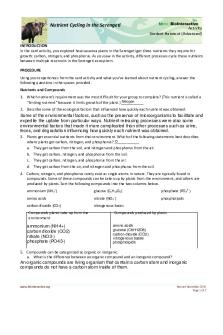Fluid and Electrolytes Quiz - Student Handout PDF

| Title | Fluid and Electrolytes Quiz - Student Handout |
|---|---|
| Author | Sahil LONGTERM |
| Course | Adult Health II |
| Institution | Galen College of Nursing |
| Pages | 3 |
| File Size | 67.5 KB |
| File Type | |
| Total Downloads | 97 |
| Total Views | 150 |
Summary
fluid and electrolytes quiz with 10 practice questions....
Description
Fluids & Electrolytes Nursing Quiz NCLEX Practice Questions 1. On morning assessment of your patient in room 2502 who has severe burns. You notice that fluid is starting to accumulate in his abdominal tissue. You note that his weight has not changed and his intake and output is equal. What do you suspect? A. Third spacing B. This is normal and expected after a burn and it is benign C. Document this finding as non-pitting abdominal edema. D. Intravascular compartment syndrome
2. Which patient is at more risk for an electrolyte imbalance? A. An 8 month old with a fever of 102.3 'F and diarrhea B. A 55 year old diabetic with nausea and vomiting C. A 5 year old with RSV D. A healthy 87 year old with intermittent episodes of gout
3. A patient is admitted to the ER with the following findings: heart rate of 110 (thready upon palpation), 80/62 blood pressure, 25 ml/hr urinary output, and Sodium level of 160. What interventions do you expect the medical doctor to order for this patient? A. Restrict fluid intake and monitor daily weights B. Administer hypertonic solution of 5% Dextrose 0.45% Sodium Chloride and monitor urinary output C. Administer hypotonic IV fluid and administer sodium tablets. D. No interventions are expected
4. After obtaining an EKG on a patient you notice that ST depression is present along with an inverted T wave and prominent U wave. What lab value would be the cause of this finding? A. Magnesium level of 2.2 B. Potassium level of 5.6 C. Potassium level of 2.2 D. Phosphorus level of 2.0
5. Which patient below would have a potassium level of 5.5? A. A 76 year old who reports taking Lasix four times a day B. A patient with Addison's disease C. A 55 year old woman who have been vomiting for 3 days consistently D. A patient with liver failure
6. You are taking a patient's blood pressure manually. As you pump up the cuff above the systolic pressure for a few minutes you notice that the patient develop a carpal spasm. Which of the following is true? A. The patient is having a normal nervous response to an inflating blood pressure cuff that is inflated above the systolic pressure B. This is known as Trousseau's Sign and is present in patients with HYPERcalcemia C. This is known as Chvostek's Sign D. This is known as Trousseau's Sign and is present in patients with hypocalcemia
7. Which patient is at most risk for hypomagnesemia? A. A 55 year old chronic alcoholic B. A 57 year old with hyperthyroidism C. A patient reporting overuse of antacids and laxatives D. A 25 year old suffering from hypoglycemia
8. In report from a transferring facility you receive information that your patient's Magnesium level is 1.2. When the patient arrives, you are ordered by the doctor to administer Magnesium Sulfate via IV. Which of the following interventions takes priority? A. Set-up bedside suction B. Set-up IV Atropine at bedside due to the bradycardia effects of Magnesium Sulfate C. Monitor the patient's for reduced deep tendon reflexes and initiate seizure precautions D. None of the above are correct
9. Which patient is at most risk for fluid volume deficient? A. A patient who has been vomiting and having diarrhea for 2 days. B. A patient with continuous nasogastric suction. C. A patient with an abdominal wound vac at intermittent suction. D. All of the above are correct.
10. A patient is admitted with exacerbation of congestive heart failure. What would you expect to find during your admission assessment? A. Flat neck and hand veins B. Furrowed dry tongue C. Increased blood pressure and crackles throughout the lungs D. Bradycardia and pitting edema in lower extremities...
Similar Free PDFs

Adaptive quiz fluid and electrolytes
- 20 Pages

Fluid and Electrolytes
- 23 Pages

Fluid and Electrolytes ( Hurst)
- 4 Pages

fluid & electrolytes
- 7 Pages

Fluid Electrolytes worksheet
- 4 Pages

Fluid & Electrolytes ATI
- 7 Pages

Fluid & Electrolytes Cheat Sheet
- 1 Pages

Student Handout
- 8 Pages

Week 4. Student Handout
- 3 Pages

Student handout 2016
- 7 Pages

Nutrient Cycling Student Handout
- 2 Pages
Popular Institutions
- Tinajero National High School - Annex
- Politeknik Caltex Riau
- Yokohama City University
- SGT University
- University of Al-Qadisiyah
- Divine Word College of Vigan
- Techniek College Rotterdam
- Universidade de Santiago
- Universiti Teknologi MARA Cawangan Johor Kampus Pasir Gudang
- Poltekkes Kemenkes Yogyakarta
- Baguio City National High School
- Colegio san marcos
- preparatoria uno
- Centro de Bachillerato Tecnológico Industrial y de Servicios No. 107
- Dalian Maritime University
- Quang Trung Secondary School
- Colegio Tecnológico en Informática
- Corporación Regional de Educación Superior
- Grupo CEDVA
- Dar Al Uloom University
- Centro de Estudios Preuniversitarios de la Universidad Nacional de Ingeniería
- 上智大学
- Aakash International School, Nuna Majara
- San Felipe Neri Catholic School
- Kang Chiao International School - New Taipei City
- Misamis Occidental National High School
- Institución Educativa Escuela Normal Juan Ladrilleros
- Kolehiyo ng Pantukan
- Batanes State College
- Instituto Continental
- Sekolah Menengah Kejuruan Kesehatan Kaltara (Tarakan)
- Colegio de La Inmaculada Concepcion - Cebu




